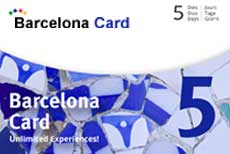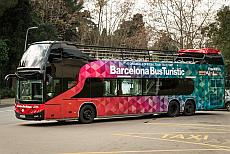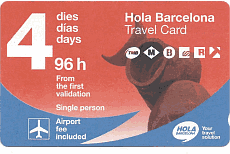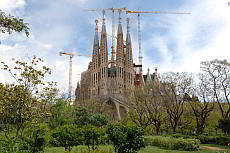Cathedral La Seu
One of the most beautiful Gothic buildings in Barcelona
The Romans had already built a temple on the slightly elevated Pla de la Seu square, where Barcelona Cathedral is located today.
Content of this page
The cathedral is dedicated to the martyr Santa Eulàlia, the patron saint of Barcelona. She was tortured to death around 290 AD. The body of Eulàlia is buried under the high altar. It is always celebrated on February 12th.
The official name of the church is Catedral de la Santa Creu i Santa Eulàlia, meaning Cathedral of the Holy Cross and Saint Eulàlia. The name "La Seu" refers more to the position of the church. La Seu roughly means headquarters or headquarters, meaning the seat of the bishop.
Although the actual Gothic church was already completed in 1448, the appearance of the church has been changed over the centuries through conversions and additions. The last major conversion was completed in 1913 with the completion of the middle tower.
City patron Santa Eulàlia
Along with La Mercè, Santa Eulàlia is Barcelona's most important patron saint. Many myths and legends surround the life and death of the martyr. Eulàlia was a ganshirt on the outskirts of Barcelona in what is now the district of Sarrià.
Cor Francesc Valls: Benjamin Britten - Rosa Mystica
Eulàlia had turned to Christianity, but they were persecuted by the local authorities on the orders of Emperor Diocletion. The 13-year-old girl appealed to Governor Decià to stop the pursuit. Decià was so angry at her request and the fact that she did not want to turn away from the faith that he had her tortured to death at the age of 13 martyrs, one for every year of her life. In the end, her eye was burned out on the cross. Her death is presumed around 290 or 12 February 303.
After her death it is said to have snowed, the snow wrapped around her lifeless body like a cloak. The cult of Eulàlia began in 877. Bishop Frodoí was looking for documents that would clarify the whereabouts of Eulàlia. The remains are said to have been very close to the Church of Santa Maria del Mar. In 878 a tomb was built for her in the cathedral and she was buried.
Today she lies in the crypt of the cathedral in a sarcophagus.
Scholars disagree as to whether the bones are really those of Eulàlia, whether they actually existed and when they actually died.
Architectural history of the Cathedral
In Barcelona, ââChristianization began early in the 3rd and 4th centuries. The martyrdom of Saint Eulàlia during the persecution of Christians under the Roman Emperor Diocletan (emperor from 284 to 305) points to this.
Based on excavations along the Carrer dels Comtes on the east side of today's cathedral, we know that an early Christian church must have stood here as early as the 4th century. It was a three-nave building. Although there are no scientifically proven documents from this time, it is assumed that it was already a cathedral, i.e. a bishopric, at that time.
The relics of Saint Eulàlia were also kept in a chapel of this early Christian church. With the conquest of the Iberian Peninsula by the Moors in 711, this was hidden in another church - probably the Santa Maria del Mar or the Santa María de les Arene. Eulàlia's bones were rediscovered in 877.
The simple cathedral survived the destruction of Barcelona by the Moorish ruler Almansor in 985. The early Christian church remained standing until the Count of Barcelona Ramon Berenguer began building a Romanesque cathedral in 1046.
This Romanesque church was completed in 1058 (the "Second Cathedral"), but as early as May 1, 1298, work was rebuilt on the remaining foundations of the early Christian church and the Romanesque cathedral by Ramon Berenguer: the current Gothic cathedral is erected.
The next 150 years from 1298 can be divided into three periods:
- The building was planned, the apse and the radial chapels were erected, the presbytery with the altar and the crypt and the transepts
- The three naves with the side chapels and extension to the choir
- Construction of the basilica, closed with a simple wall in 1417. The monastery with its cloister was completed in 1448.
The unadorned facade seemed to bother some people: on the initiative of the industrialist Manuel Girona Agrafel, construction of the facade began at the end of the 19th century based on original plans from the 15th century. The neo-Gothic façade and the two side towers were then inaugurated in 1913.
The interior of the current building
Barcelona Cathedral has three naves but only one apse. The naves consist of five sections, the one on the facade being the longest.
In order to be able to use the space between the smaller buttresses of the aisles, the Catalan Gothic structure envisages secondary chapels around the whole building. Each of the sections, the boundary of which is marked by powerful columns between the naves, has two of these inwardly open chapels.
Dimensions
The external dimensions of the church are 93 meters long, 40 meters wide and the central nave is 28 meters high.
Inside, the church is 25 meters wide, excluding the chapels. Each chapel is 9 meters high, 5 meters wide and 6 meters deep. There are 28 of them in the church. The central nave is 26 meters high and 13 meters wide. The aisles are 21 meters high and 6 meters wide. The supporting columns are 15 meters high up to the arch.
Choir stalls
The construction of the cathedral's choir stalls in the middle of the nave began in 1390 by order of Bishop Raymund d'Escales. The stalls are among the most important Gothic sculptural works in Catalonia. This detail of the cathedral was also built over a long period of time and added to again and again: at the end of the 15th century, the sculptor Michael Lochner and his student Johan Friedrich created the canopies and battlements. The commemorative plaques were painted by Juan de Borgoña in 1517-18. They refer to the Knights of the Order of the Golden Fleece, who were called to Barcelona in 1519.
The wooden chancery on the right at the entrance to the choir dates from 1403.
Keystones
When it was discovered that the cathedral's 215 keystones were polychromatic rather than monochromatic, they were restored in 1970. The keystones show images of saints venerated in the church.
Organ
The organ is located under the bell tower in the nave, in the gallery above the Sant Ivo entrance. The artistically, liturgically and historically significant object was built from 1537 to 1539. From 1985 to 1994 it was extensively restored. Since 1990 there has been an organ concert once a month. The organ also accompanies the Eucharistic celebrations and the services.
The cloister, the geese and the dancing egg
You should definitely see the cloister with small chapels, gardens, fountains, medieval tombstones and even geese, whose cackling you can hear from inside the church building.
The cool cloister is particularly beneficial on hot summer days.
From the cloister you can reach the small museum. In this museum you will find two very precious statues representing Santa Eulàlia and an equally precious monstrance made of solid gold. A monstrance is a liturgical display device in which the host is presented. In the "Sala Capitular" you can also admire beautiful ceiling paintings.
White geese
The 13 white geese that run around the cloister garden every day are supposed to symbolize the age of Eulàlia when she suffered her martyrdom. That may well be true, also that Eulàlia was a goose herder. However, we owe the existence of this tradition of keeping geese to a very practical characteristic of geese: their deafening noise was a good deterrent against unwanted intruders and thieves.
The custom of the dancing ice cream (L'ou com balla)
The monastery fountain in the cloister is always decorated with flowers on Corpus Christi. The custom consists of making an egg dance on the water. This tradition dates back to at least 1636.
Why visit the Cathedral
The Cathedral is a very beautiful and unique church building. The Gothic church building would actually have been finished in 1417 or 1448 with the completion of the cloister. The dreary facade and the lack of a "real" church tower prompted Manuel Girona Agrafel to expand the church with a neo-Gothic facade and representative church tower. The Cathedral can certainly serve as a good example of how many sacred buildings built over the centuries mixed styles.
The interior of the church is more than impressive, here you can experience many centuries of Barcelona's history. On the roof you have a fantastic view over the Gothic Quarter. The 13 geese in the courtyard of the cloister are special, but the complex is very beautiful and quiet.
Book here tickets and tours in the Gothic quarter
Important information
Surroundings
Find Hotels nearby
Address
Plaça de la Seu, 7
Arrival
Metro: Jaume I. (L4)
Bus Turístic: Barri Gòtic
Parking nearby
Opening times
Weekdays: 09.30 - 18:30 (last entry 17.45)
Saturdays and religious holidays: 09.30 - 17.15 (last entry 16.30)
Sundays and religious holidays: 14.00 - 17.00 (last entry 16.30)
Admission
People 13+: €16.50
Children 4 - 12 years: €7.50
Children up to 3 years: free admission
Tips for the visit of the cathedral
With the paid admission you can visit the following areas: the dom and the cloister, the roof, the choir stalls, the chapter house, the Jewish memorial room with original documents from the archive from 1535, the museum and the chapel of St. Christ of Lepanto.
You can also visit the cathedral without paying an admission fee, outside the tourist times (see above). The cathedral and the cloister are then accessible. Please note: outside these times there also masses are held, which should not be disturbed.
If you would like to enjoy this beautiful church building in a more detailed and quiet way, the paid admission fee is definitely worthwhile.
You should allow about 1-1.5 hours for the visit.
Book your accommodation in Barcelona here! All categories.
1-5*-hotel rooms, apartments, hostels.








